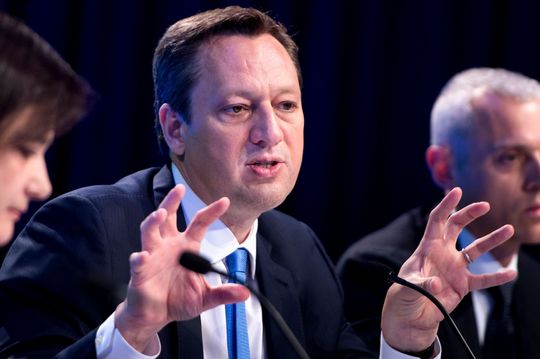The head of the International Monetary Funds market oversight department said Thursday he wouldn’t be surprised by a further selloff in U.S. equity markets this year, as the Federal Reserve moves to tighten financial market conditions in an effort to control inflation.
“For monetary tightening to impact inflation, you have to slow down the real economy and to slow down the economy you have to tighten financial conditions. There’s no question about that,” Tobias Adrian, head of the IMF’s monetary and capital markets department said, in an interview.
But the Fed’s main policy tool is its short-term interest rate and how that impacts broader financial conditions is uncertain. So exactly how many rate hikes will be needed to get inflation under control is a difficult question.
Given the recent high U.S. inflation readings and the pivot by the Fed toward tightening monetary policy, the 10-year real yield has increased by nearly half a percentage point this year. Stock market volatility has accelerated with the S&P 500 SPX, +2.43% down more than 9% for the year and the Nasdaq Composite measure COMP, +3.13% tumbling 14%.
“I think we saw a 9% selloff and, you know, that seems reasonable to me. But I wouldn’t be surprised if we saw some further selloffs down the line. I don’t know when but going forward this year we might see further selloffs,” Adrian said.
At the moment, the Fed’s short-term policy rate is close to zero. After Fed Chairman Jerome Powell’s press conference on Wednesday, markets are pricing in the strong likelihood of five quarter percentage point rate hikes this year, up from four moves prior to Wednesday’s press conference. Five quarter-point hikes would would bring the Fed’s policy rate up to 1.5%.
Economists note that that level of policy rate is still below the most recent Fed’s estimate of a “neutral” rate of 2.5%.
The Fed might have to “go beyond that” to get inflation under control, Adrian said.
“You might have to go to 3.0%-3.5%,” Adrian said, adding that this level is not fully priced into the markets.
Many economists think raising rates to 3% or more would cause the yield curve to invert and the U.S. economy to falter.
“If you aim for a terminal rate overshoot over the neutral rate , then you’re courting the greater risk of a hard landing,” said Derek Holt, head of capital markets economics at Scotiabank in Toronto.
He thinks the “terminal rate” for the Fed will be around 2.25% and that will come by early in 2023.
In the interview, Adrian also said he thought there was “a very high bar” on any so-called Fed put option, or the level where the central bank would shift policy in a dovish direction in response to financial market weakness.
“The goal is not to ease right now, the goal is to tighten. So I would expect there is a very high bar for the Fed to come in, in terms of market functioning issues,” he said.
On China, Adrian said he wasn’t worried about any spillover to the global economy from the weaker outlook for the world’s second-largest economy.
Asked about the risk for emerging and developing countries from the Fed shift toward tighter policy, Adrian said the fallout should be contained.
“It is important to keep in mind we had very easy financial conditions globally. They need to be tightened to some extent. There has to be some degree of normalization. So as long as that is orderly, the fallout should be contained,” he said.
There are some major emerging markets that already have challenges and those will be reinforced.
“We could see some different countries falling into stress,” he added.

